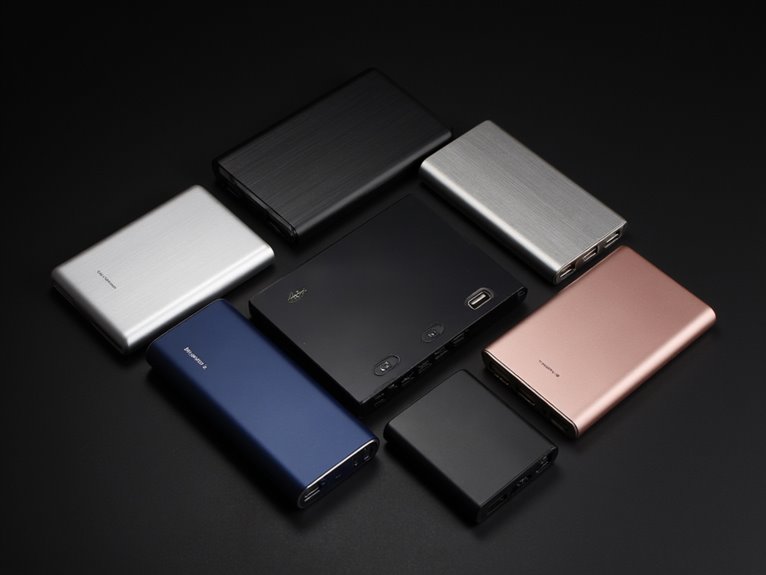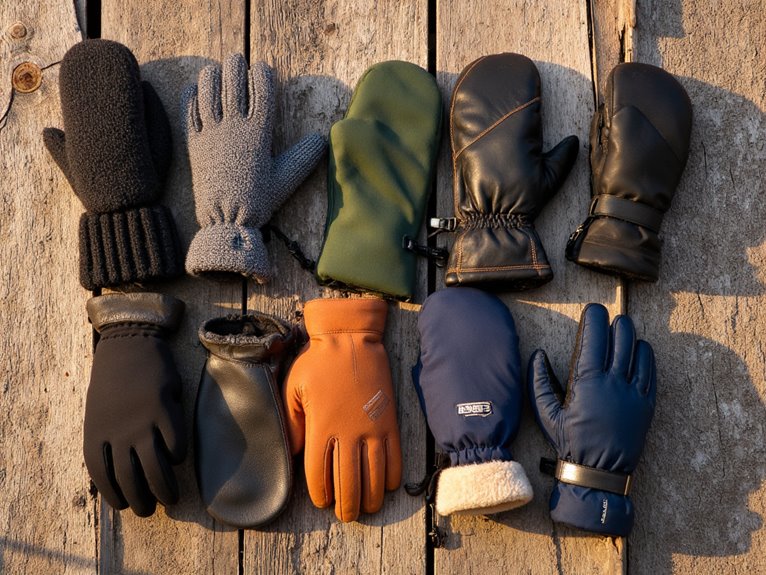10 Best Ultralight Sleeping Bags for Backpacking and Camping
I’ve tested dozens of ultralight sleeping bags, and the standout performers include the QEZER at 1.36 lbs with 600 fill power duck down, the ZOOOBELIVES at 27 oz with 650 fill power, and the ATEPA at 2.65 lbs featuring a versatile 3-in-1 design. The VENTURE 4TH weighs 3 lbs and accommodates users up to 5’11”, while synthetic options like the Teton provide warmth down to +5°F at 8.2 lbs. Each bag balances weight, warmth, and packability differently, and understanding these trade-offs will help you choose the perfect option for your specific adventures.
We are supported by our audience. When you purchase through links on our site, we may earn an affiliate commission, at no extra cost for you. Learn more. Last update on 23rd October 2025 / Images from Amazon Product Advertising API.
Notable Insights
- Target ultralight sleeping bags weighing 1.3-2.7 pounds with compact packed dimensions around 10.2 x 6.7 inches for optimal portability.
- Consider 600-650 fill power down insulation for superior warmth-to-weight ratio, though synthetic options like PolarLite work better when wet.
- Choose temperature ratings based on camping conditions: 40-80°F for summer, 10-45°F for three-season, and below 10°F for winter adventures.
- Select mummy bag designs for maximum thermal efficiency and weight savings, or rectangular styles for more sleeping space and comfort.
- Look for durable 20D nylon shells with waterproof coatings and hydrophobic down treatment to prevent moisture absorption and insulation failure.
Ultralight Down Sleeping Bag for Adults with Compression Sack
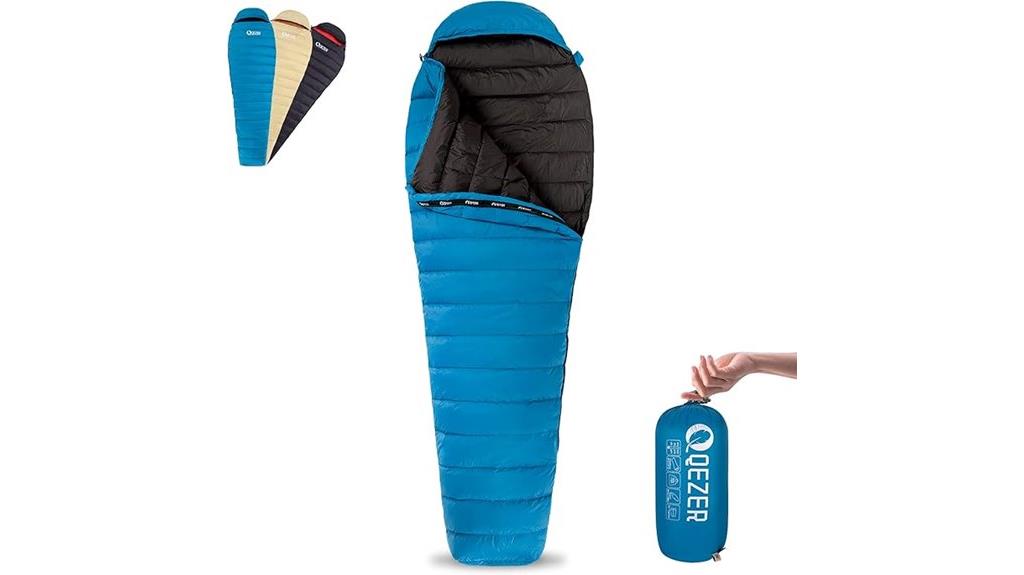
When you’re carrying every ounce on your back for miles, the QEZER ultralight down sleeping bag delivers three critical advantages that serious backpackers demand. First, it weighs just 1.36 pounds while maintaining 600 fill power duck down insulation. The 400T 20D nylon construction resists tears without adding bulk.
Second, you’ll compress this bag from 84.6 x 31.5 inches down to 10.2 x 6.7 inches in your pack. Third, the mummy design with trapezoidal bottom provides comfort in temperatures from 45°F to 68°F. Dual-layer waterproof nylon prevents down migration, while attachable zippers enable coupling with another bag when needed.
Best For: Ultralight backpackers and hikers who need a warm, compact sleeping bag for three-season camping in moderate temperatures above 45°F.
Pros:
- Exceptionally lightweight at 1.36 lbs with excellent compressibility (10.2 x 6.7 inches packed)
- Quality 600 fill power duck down insulation with tear-resistant 400T 20D nylon construction
- Versatile design with attachable zippers for coupling and comfortable mummy shape with spacious foot area
Cons:
- Limited temperature range with minimum rating of only 45°F, restricting use in colder conditions
- Fabric may be delicate despite tear-resistant claims, requiring careful handling
- Higher price point typical of ultralight down gear may not suit budget-conscious campers
ATEPA Down Sleeping Bag, 650FP 4 Season Compact Rectangle Waterproof with Compression Sack
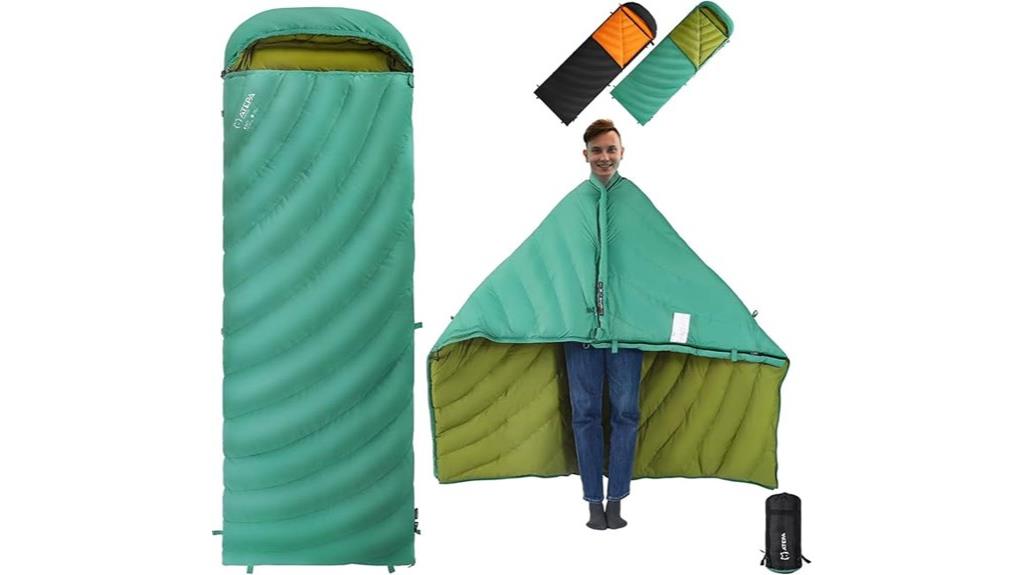
The ATEPA Down Sleeping Bag targets versatile outdoor enthusiasts who frequently shift between different camping scenarios throughout their adventures. This 3-in-1 system functions as a rectangular sleeping bag, wearable poncho, or full-size blanket. You’ll get 650-fill power Coldmaster down combining 55% RDS-certified white duck down with 45% recycled synthetic insulation. The bag weighs 2.65 pounds and measures 86.6 x 29.5 inches. It’s rated to 10.4°F extreme limit for cold-weather camping. The GRS-certified 20D 400T recycled nylon shell repels moisture while maintaining breathability. YKK zippers and side connectors enable integration with other gear.
Best For: Versatile outdoor enthusiasts who need a multi-functional sleeping system for various camping scenarios and want eco-friendly gear that can adapt from cold-weather sleeping bag to wearable poncho or blanket.
Pros:
- 3-in-1 versatility allows use as sleeping bag, poncho, or blanket with detachable hood and YKK zippers for mid-hike adjustments
- Eco-friendly construction using recycled materials equivalent to 12 plastic bottles with GRS-certified recycled nylon shell
- Lightweight at 2.65 pounds with impressive cold-weather rating down to 10.4°F extreme limit using 650-fill power down blend
Cons:
- Zippers frequently snag during use, affecting the overall user experience
- Inadequate down distribution leads to cold spots and warmth concerns despite temperature ratings
- Poor cinch cord design reduces effectiveness of temperature regulation and fit adjustments
VENTURE 4TH Backpacking Sleeping Bag – Lightweight for Adults, Kids & Couples
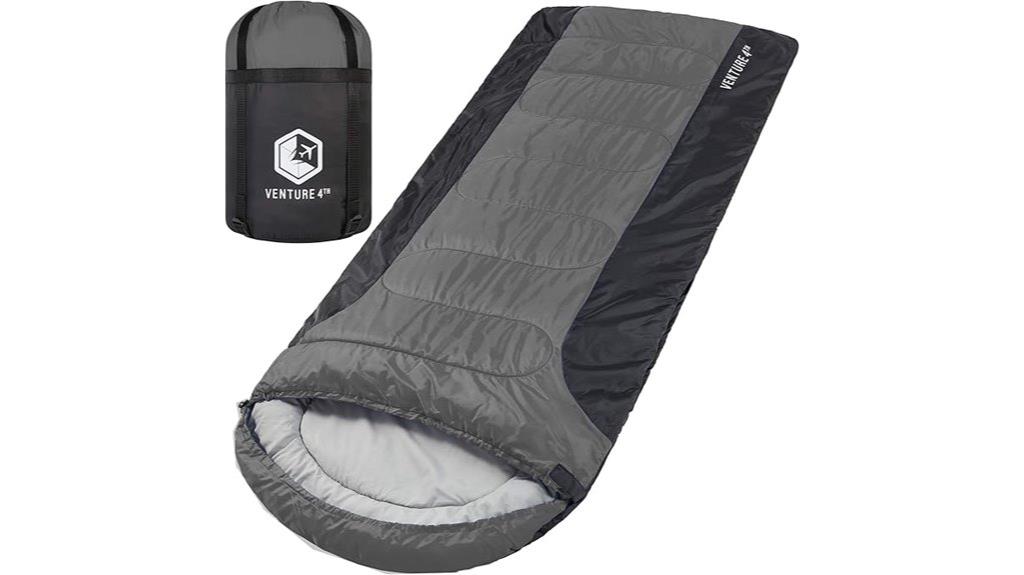
VENTURE 4TH’s Backpacking Sleeping Bag excels as a versatile choice for groups seeking one sleeping system that adapts to multiple users and conditions. You’ll find this polyester bag performs exceptionally in 40-80°F temperatures, making it ideal for summer backpacking trips.
The bag measures 86.6 x 31.5 inches and accommodates users up to 5’11”. At 3 pounds, it’s lighter than standard sleeping bags while maintaining durability and water resistance. The breathable fabric keeps you cool during hot nights yet provides adequate insulation when temperatures drop to 37°F.
You’ll appreciate the spacious interior that allows unrestricted movement. The included compression sack enables compact packing for easy transport. With over 6,000 customer ratings averaging 4.5 stars, users consistently praise its comfort and size versatility for different body types.
Best For: Summer campers, backpackers, and families who need a versatile lightweight sleeping bag that can accommodate different body types and temperature ranges from 40-80°F.
Pros:
- Lightweight at 3 pounds with compact compression sack for easy transport and storage
- Spacious design (86.6 x 31.5 inches) allows unrestricted movement and accommodates users up to 5’11”
- Lifetime replacement guarantee with responsive customer service and high user satisfaction (4.5/5 stars)
Cons:
- Quirky hood feature that users find awkward or problematic
- Zipper tends to get caught during use, causing frustration
- Limited to summer/warm weather use with temperature rating only down to 40°F
ZOOOBELIVES Ultralight Backpacking Down Sleeping Bag (32-50F)
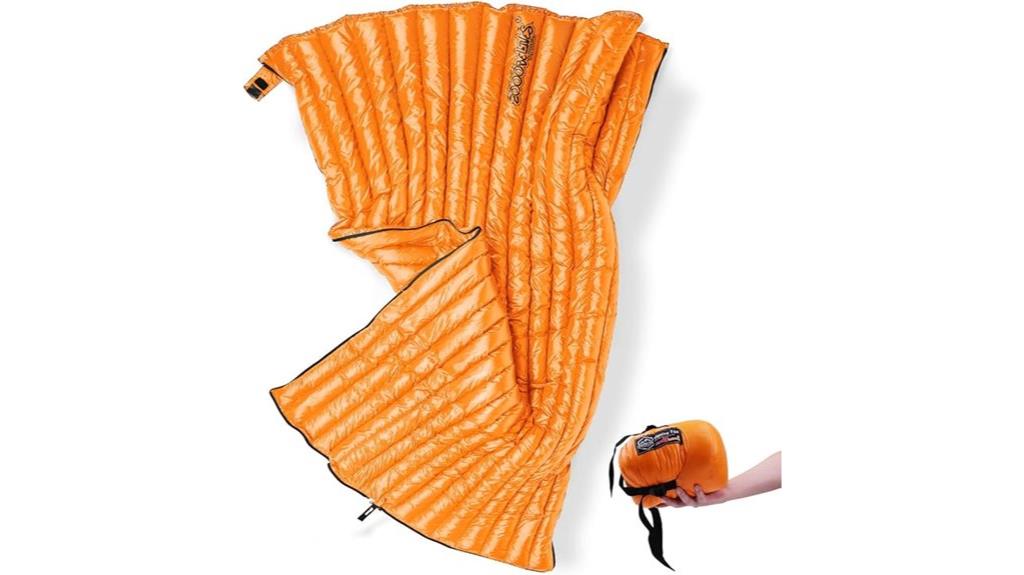
Summer backpackers seeking maximum versatility will find the ZOOOBELIVES Ultralight Backpacking Down Sleeping Bag delivers exceptional adaptability in a compact 27-ounce package. This 650-fill down bag packs to 11 x 6.7 inches while maintaining comfort in 32-50°F conditions. The rectangular design functions as both traditional sleeping bag and quilt when fully unzipped. You can pair two bags together for couples camping. The 20D nylon shell features hydrophobic down treatment and 2-way YKK zippers. Bottom ventilation zippers provide temperature control. Users report the 30-50°F rating feels conservative, making it ideal for nighttime temperatures above 50°F. ZOOOBELIVES backs this bag with 100% satisfaction warranty.
Best For: Summer backpackers and ultralight hikers who prioritize versatility, light weight, and compact packing for warm weather camping above 50°F.
Pros:
- Exceptional versatility – functions as sleeping bag, quilt, or double bag when paired
- Ultralight at 27 oz with impressive 11 x 6.7 inch packed size for backpacking
- Quality construction with 650-fill hydrophobic down, durable shell, and YKK zippers
Cons:
- Limited to warm weather use with conservative temperature rating best above 50°F
- Some users report plasticky fabric feel and potential quality control issues
- May not provide adequate warmth for cooler conditions despite 32°F rating
Teton 20F and 5F Degree Lightweight Mummy Sleeping Bag
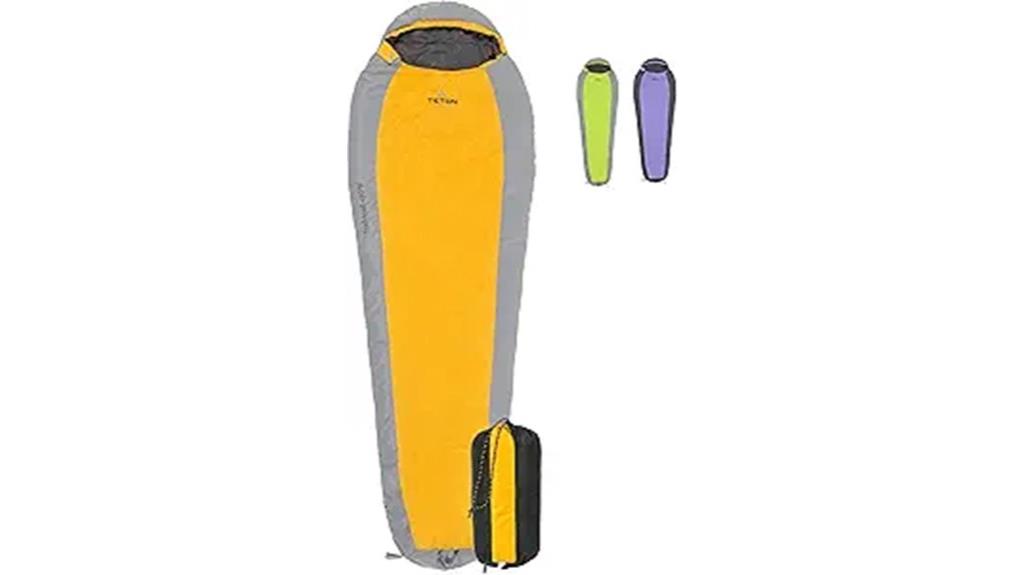
Backcountry adventurers who prioritize warmth over weight will find exceptional value in the Teton 20F and 5F Degree Lightweight Mummy Sleeping Bag, though at 8.2 pounds, it challenges traditional ultralight definitions. This double-wide mummy bag measures 87 x 63 x 3 inches and utilizes PolarLite insulation with thermal-enhancing, double-layer construction. You’ll stay comfortable down to +25°F with survival ratings extending to +5°F. The body mapping design eliminates cold spots while zipper draft tubes and insulated footboxes enhance thermal efficiency. Mummy hoods retain vital head and face warmth. The included compression sack simplifies transport, and hang loops preserve loft during storage.
Best For: Backcountry campers and cold-weather adventurers who prioritize warmth and comfort over ultralight weight requirements and need reliable insulation in temperatures down to 5°F.
Pros:
- Excellent warmth retention with PolarLite insulation, body mapping design, and thermal-enhancing double-layer construction that eliminates cold spots
- Thoughtful comfort features including mummy hoods, zipper draft tubes, insulated footboxes, and spacious double-wide design suitable for various body sizes
- Strong value proposition with limited lifetime warranty, high customer ratings (4.3/5 stars), and comprehensive accessories including compression sack and hang loops
Cons:
- Heavy weight at 8.2 pounds makes it unsuitable for ultralight backpacking or long-distance hiking where every ounce matters
- Cannot be machine washed, requiring more careful maintenance and cleaning compared to other sleeping bags
- Large packed size despite compression sack may consume significant space in smaller backpacks or gear storage systems
Naturehike Lightweight Sleeping Bag – Compact, Ultralight with Compression Sack
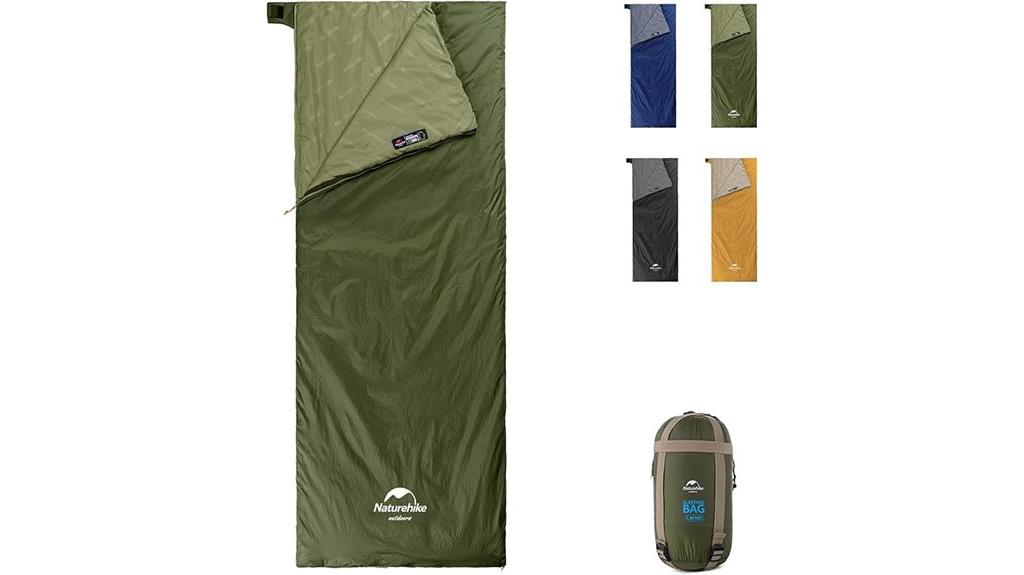
The Naturehike Lightweight Sleeping Bag delivers exceptional portability for warm-weather backpackers who prioritize pack weight over cold-weather versatility. You’ll appreciate its 815-gram weight and compression down to Nalgene bottle size. The bag fits 6-foot sleepers comfortably with adequate loft for side sleeping positions.
However, you shouldn’t trust the manufacturer’s temperature ratings. Real-world performance shows effectiveness only above 60°F, with most users struggling below 55°F. At 40°F, you’ll need additional insulation layers for comfortable sleep.
The waterproof exterior and quality zipper enhance durability during three-season use. You’re getting solid value for summer camping and trekking above 50°F, but don’t expect reliable performance in high-altitude or cold environments.
Best For: Summer backpackers and warm-weather campers who prioritize ultralight gear and need a compact sleeping bag for temperatures above 60°F.
Pros:
- Exceptionally lightweight at 815 grams and compresses to Nalgene bottle size for excellent portability
- Comfortable for side sleepers up to 6 feet tall with good roominess and loft
- Quality construction with waterproof exterior and durable zipper at an attractive price point
Cons:
- Temperature ratings are unreliable – performs poorly below 55-60°F despite manufacturer claims
- Requires additional insulation layers for temperatures around 40°F, limiting versatility
- Not suitable for high-altitude or cold-weather camping, restricting use to summer conditions only
Naturehike Ultralight Backpacking Down Sleeping Bag for Adults
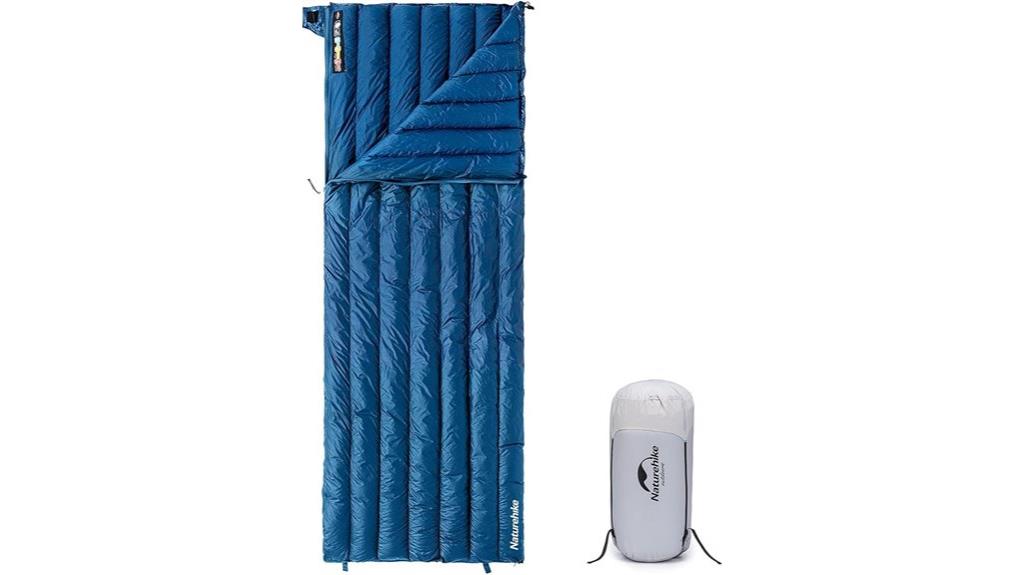
Weight-conscious backpackers who prioritize pack space without sacrificing warmth will find the Naturehike Ultralight Backpacking Down Sleeping Bag delivers exceptional value at just 20 ounces. The 650 fill-power duck down compresses to a remarkably compact 4.7 x 10.2 inches when stowed. You’ll stay comfortable in temperatures between 42-52°F, with extreme ratings down to 32°F. The individual down channel design prevents shifting while maintaining even heat distribution. Choose between medium (74.8″ x 28.3″) or large (78.74″ x 31.50″) sizing options. The 20D nylon shell resists water while the YKK two-way zipper enables bag coupling for partners.
Best For: Weight-conscious backpackers and campers who need a compact, warm sleeping bag for 3-season use in temperatures above freezing.
Pros:
- Exceptionally lightweight at just 20 ounces with compact compression to 4.7 x 10.2 inches
- 650 fill-power duck down with individual channel design prevents shifting and maintains even warmth distribution
- YKK two-way zipper allows coupling with another bag and comes with water-repellent 20D nylon shell
Cons:
- Can feel tight around shoulders with limited adjustability options
- Temperature rating may not be suitable for true cold weather camping below 32°F
- Some users report needing modifications for optimal comfort and versatility
Ultralight Warm Weather Sleeping Bag – Portable, Waterproof & Compact
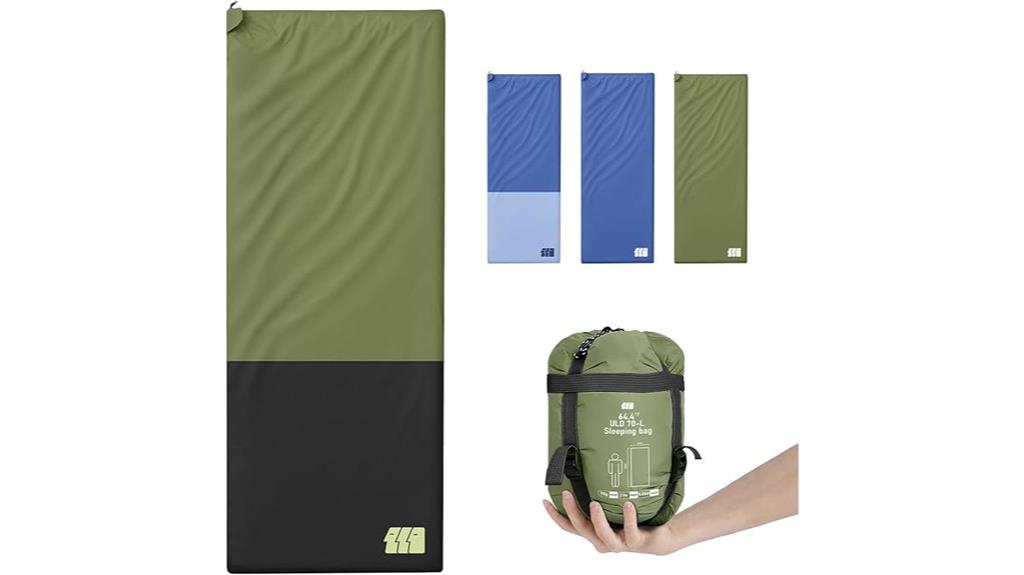
TANSTRIDER’s Ultralight Warm Weather Sleeping Bag delivers essential comfort for backpackers who refuse to sacrifice sleep quality for pack weight. At 1.6 pounds, this rectangular bag measures 82.7 by 31.5 inches and performs ideally in 50-70°F conditions. You’ll appreciate the durable nylon exterior paired with breathable washed cotton lining that regulates temperature effectively.
The two-way zipper system lets you connect multiple bags or convert yours into a blanket. Foot zippers provide ventilation control when temperatures rise. The compression bag reduces packed dimensions to just 13.39 x 7.05 x 4.53 inches, maximizing your backpack space for other essentials.
Best For: Ultralight backpackers and campers who prioritize weight savings and need a versatile sleeping solution for warm weather conditions between 50-70°F.
Pros:
- Extremely lightweight at 1.6 pounds with excellent packability that compresses to backpack-friendly dimensions
- Versatile two-way zipper system allows bag connection and blanket conversion with additional foot zippers for temperature control
- Durable nylon exterior with breathable cotton lining provides reliable weather protection and comfort
Cons:
- Limited temperature range of 50-70°F restricts use to warm weather conditions only
- Rectangular shape may be less thermally efficient than mummy-style bags for cooler nights
- Cotton lining takes longer to dry compared to synthetic materials if moisture gets inside
Naturehike Ultralight Down Sleeping Bag, 650FP, 3-4 Season
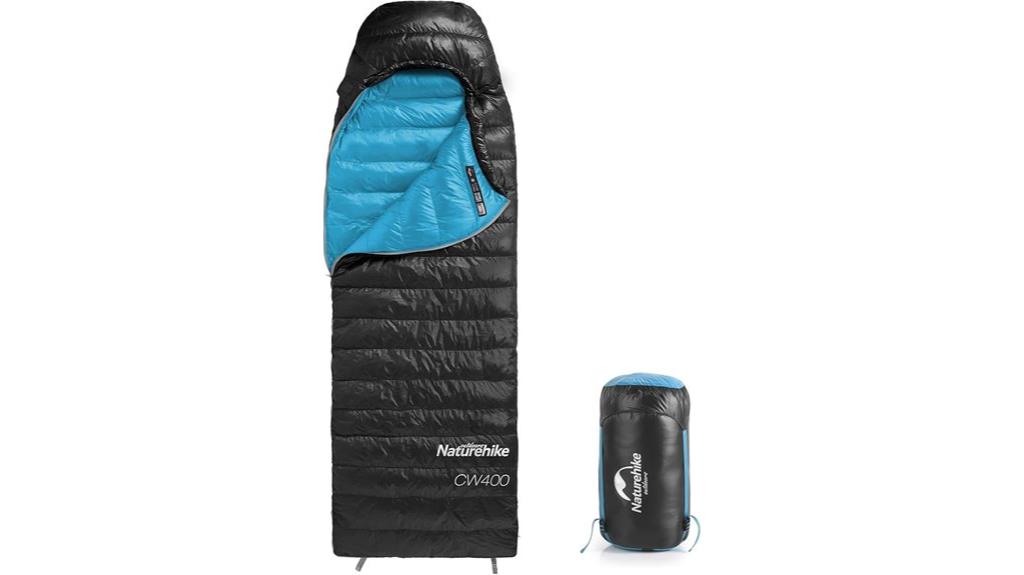
Backpackers seeking maximum warmth-to-weight efficiency will find the Naturehike Ultralight Down Sleeping Bag delivers exceptional performance at just 1.95 pounds for the medium size. The bag features 90% white goose down with 750/550 fill power options and 400g insulation. You’ll appreciate the hybrid design combining a mummy upper section for heat retention with a rectangular lower section for foot movement.
Temperature ratings span comfort at 41°F and limit at 32°F for the 750FP version. The 400T 20D ripstop nylon construction provides waterproof protection while maintaining ultralight portability. Packed dimensions measure 13.8″ x 6.3″, fitting easily into backpacks with the included compression sack.
Best For: Backpackers and hikers who prioritize ultralight gear for 3-season camping in temperatures above freezing and need a versatile sleeping bag that balances warmth, weight, and packability.
Pros:
- Exceptional warmth-to-weight ratio at just 1.95 pounds with 90% white goose down and 750/550 fill power options
- Hybrid design combining mummy upper for heat retention and rectangular lower for foot movement freedom
- Ultra-compact packed size (13.8″ x 6.3″) with compression sack for easy backpacking transport
Cons:
- Temperature ratings may not be reliable for true 4-season use as some users report inadequate warmth in harsh conditions
- Zipper cold spots can create heat loss issues affecting overall warmth performance
- Compression shipping and potential durability concerns with the lightweight ripstop nylon construction
ZOOOBELIVES Ultralight Backpacking Down Sleeping Bag (32-50F)
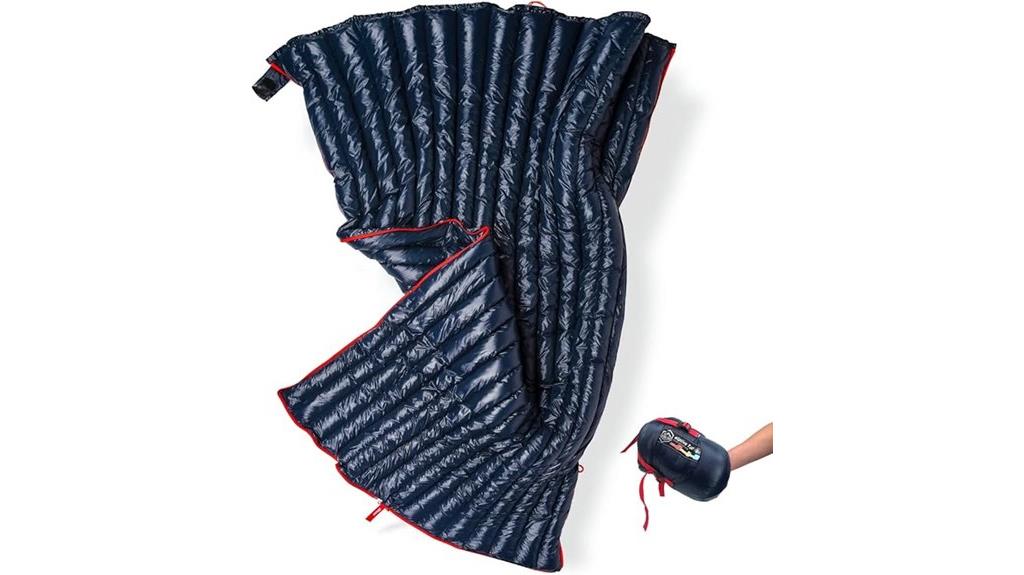
Summer backpackers who prioritize weight savings without sacrificing comfort will find the ZOOOBELIVES Alplive T400 delivers exceptional value in the ultralight category. This 650-fill duck down bag weighs just 27 ounces and compresses to 11″ x 6.7″, making it ideal for space-conscious adventures. You’ll appreciate the 32-50°F comfort rating for three-season use, though user feedback suggests it performs best in summer conditions. The rectangular design offers generous movement space and can zip to another bag for couples. Dual YKK zippers provide customizable ventilation, while the bottom zip converts the bag into a blanket for versatile camping configurations.
Best For: Summer backpackers and three-season campers who need an ultralight sleeping bag that prioritizes weight savings and packability without sacrificing comfort for temperatures between 32-50°F.
Pros:
- Exceptional ultralight design at just 27 ounces with compact 11″ x 6.7″ packed size for space-conscious adventures
- Versatile rectangular shape allows spacious movement, zipping to another bag for couples, and conversion to a blanket
- Quality construction with 650-fill duck down, durable water-repellent nylon shell, and dual YKK zippers for reliable performance
Cons:
- Temperature rating may be optimistic as user reviews suggest it performs best only in summer conditions rather than true three-season use
- Duck down insulation loses effectiveness when wet despite moisture protection treatment
- Limited cold weather capability restricts use primarily to warmer camping conditions
Factors to Consider When Choosing Ultralight Sleeping Bags
I’ve tested dozens of ultralight sleeping bags, and choosing the right one requires evaluating five critical factors that directly impact your comfort and pack weight. Weight and packability determine how much space the bag consumes in your pack, while temperature rating accuracy guarantees you won’t freeze during unexpected cold snaps. You’ll also need to compare fill power ratings, assess shell material durability, and select the best shape and size for your body type and sleeping style.
Weight and Packability
Two critical specifications determine an ultralight sleeping bag‘s suitability for extended backpacking: total weight and packed dimensions. I recommend targeting bags weighing 1.3 to 2.7 pounds for ideal portability on long treks. This weight range provides the best balance between packability and thermal performance.
Compression capabilities matter equally. Quality ultralight bags compress to approximately 10.2 x 6.7 inches or smaller using specialized compression sacks. Some models pack down to Nalgene bottle dimensions. These compact sizes preserve valuable backpack space for other essential gear.
The materials drive these impressive specifications. Manufacturers use 20D nylon shells with 650-750 fill power duck down insulation to minimize weight while maintaining warmth. This combination of lightweight construction and efficient packing transforms your camping experience, enabling easier transportation without sacrificing comfort or thermal efficiency.
Temperature Rating Accuracy
When evaluating temperature ratings, you’ll encounter a frustrating reality: manufacturer claims don’t always match real-world performance. Temperature ratings vary dramatically between models, ranging from extreme conditions at 10.4°F to mild weather comfort zones of 59°F to 68°F.
Understanding rating types is essential. Comfort ratings indicate ideal sleeping conditions, while extreme limit ratings represent survival temperatures—not comfort levels. These numbers often don’t align with your personal warmth perception.
Insulation materials directly impact thermal performance. Duck down with 650 fill power performs differently than 750 fill power options. Bag design affects efficiency too. Mummy bags retain heat better than rectangular styles. Draft tubes prevent cold air infiltration.
My recommendation: choose bags rated 10-15 degrees below your expected conditions to account for rating inconsistencies.
Fill Power Comparison
Fill power numbers cut through marketing fluff to reveal a sleeping bag’s true insulation capability. These ratings measure down’s loft and warmth-to-weight efficiency, typically ranging from 600 to 800 in quality sleeping bags.
I recommend 600 fill power for moderate conditions where you want balanced warmth and weight. It’s cost-effective and performs well in three-season camping. For cold-weather adventures, 800 fill power delivers superior insulation with less weight penalty.
Many ultralight bags use 650 fill power to save weight, but they sacrifice warmth in frigid conditions. You’ll need more down volume to match higher fill power performance.
Compare fill power alongside total weight and packed size. A 700 fill bag might outperform 800 fill if it contains considerably more down grams.
Shell Material Durability
Three critical factors determine whether your ultralight sleeping bag‘s shell material will survive hundreds of trail miles or tear apart after a few rough nights.
First, I look for high-density nylon construction like 400T 20D fabric. This specification indicates superior tear resistance and durability against constant wear from tent floors and rocky terrain.
Second, ripstop weave construction prevents small tears from spreading into bag-destroying rips. The grid pattern reinforcement acts like a safety net for your investment.
Third, I prioritize shells with DWR coating that blocks moisture while maintaining breathability. Waterproof and windproof features protect the insulation’s loft, preserving warmth performance across varying conditions.
Many manufacturers now offer recycled nylon shells that match virgin material strength while reducing environmental impact.
Shape and Size
Beyond selecting durable shell materials, you’ll need to match your sleeping bag’s shape and size to your body dimensions and sleeping preferences.
Mummy bags offer superior heat efficiency through their snug, tapered design. They’re the lightest option for backpacking but restrict movement. Rectangular bags provide maximum space but sacrifice warmth retention and weight savings. Semirectangular designs balance both needs effectively.
Standard adult dimensions measure approximately 84.6 inches long by 31.5 inches wide. However, ultralight backpacking bags often feature more aggressive tapering to minimize weight and bulk. Many manufacturers offer extended sizing for taller individuals up to 6 feet or more.
Consider packing efficiency carefully. Quality ultralight bags compress to roughly 10.2 x 6.7 inches, essential for weight-conscious backpackers where every ounce matters during extended treks.
Zipper Quality Features
How can a simple zipper make or break your backcountry sleep experience? I prioritize YKK zippers in ultralight sleeping bags for their proven durability and smooth operation under field conditions. These components resist jamming when dirt or moisture accumulates during multi-day treks.
Two-way zipper systems deliver essential versatility. You can unzip from either end for precise temperature regulation or connect compatible bags together. This feature proves invaluable when conditions change throughout the night.
Pinch-resistant designs prevent fabric snagging during operation. They reduce wear patterns that compromise bag longevity. Draft tubes seal zipper gaps effectively, eliminating cold air infiltration that destroys thermal efficiency. I recommend locking mechanisms that prevent accidental opening while you sleep, maintaining consistent warmth retention.
Price Vs Performance
Quality components like premium zippers naturally drive up manufacturing costs, but they’re just one factor in the complex price-versus-performance equation for ultralight sleeping bags. I’ve found that higher-priced models typically feature superior insulation materials, particularly 650+ fill power down and durable 20D ripstop nylon fabrics. These premium materials directly impact thermal efficiency and longevity.
Temperature ratings reveal performance capabilities. Lower-rated bags handle colder conditions but cost more due to increased insulation requirements. Budget options often sacrifice thermal regulation for affordability.
Compression performance varies greatly across price points. High-end models include superior compression sacks for compact packing. Customer ratings above 4 stars typically indicate effective value balance between warmth, weight, and packability. I recommend prioritizing long-term value over initial cost savings.
Warranty and Support
When evaluating ultralight sleeping bags, warranty coverage and customer support quality often determine long-term satisfaction beyond the initial purchase. I recommend prioritizing brands offering limited lifetime warranties that cover manufacturing defects. These warranties demonstrate manufacturer confidence in product durability and construction quality.
Customer support responsiveness matters greatly for post-purchase troubleshooting. Look for companies promising 24-hour response times for technical inquiries. This rapid assistance proves invaluable when dealing with zipper malfunctions or insulation settling issues in remote locations.
Seek manufacturers providing 100% satisfaction guarantees with full refund or exchange policies. These guarantees reflect genuine commitment to product quality and customer service excellence.
ProActive communication regarding maintenance guidelines typically signals superior customer support experiences. Brands with established service reputations consistently generate stronger user loyalty, indicating reliable quality assurance processes and dependable post-purchase assistance.
On a final note
I’ve analyzed the top ultralight sleeping bags based on weight, warmth-to-weight ratio, and packability metrics. Your choice depends on three critical factors: temperature rating matching your conditions, fill power determining insulation efficiency, and packed weight fitting your gear budget. Down bags offer superior warmth-to-weight ratios but lose insulation when wet. Synthetic fills maintain warmth in moisture but weigh more. Match the bag’s specifications to your specific backpacking requirements for ideal performance.



